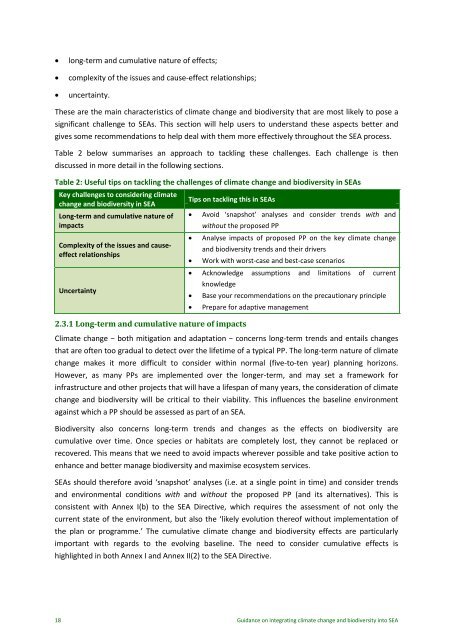Guidance on Integrating Climate Change and Biodiversity into ...
Guidance on Integrating Climate Change and Biodiversity into ...
Guidance on Integrating Climate Change and Biodiversity into ...
Create successful ePaper yourself
Turn your PDF publications into a flip-book with our unique Google optimized e-Paper software.
• l<strong>on</strong>g-term <strong>and</strong> cumulative nature of effects;• complexity of the issues <strong>and</strong> cause-effect relati<strong>on</strong>ships;• uncertainty.These are the main characteristics of climate change <strong>and</strong> biodiversity that are most likely to pose asignificant challenge to SEAs. This secti<strong>on</strong> will help users to underst<strong>and</strong> these aspects better <strong>and</strong>gives some recommendati<strong>on</strong>s to help deal with them more effectively throughout the SEA process.Table 2 below summarises an approach to tackling these challenges. Each challenge is thendiscussed in more detail in the following secti<strong>on</strong>s.Table 2: Useful tips <strong>on</strong> tackling the challenges of climate change <strong>and</strong> biodiversity in SEAsKey challenges to c<strong>on</strong>sidering climatechange <strong>and</strong> biodiversity in SEATips <strong>on</strong> tackling this in SEAsL<strong>on</strong>g-term <strong>and</strong> cumulative nature ofimpacts• Avoid ‘snapshot’ analyses <strong>and</strong> c<strong>on</strong>sider trends with <strong>and</strong>without the proposed PP• Analyse impacts of proposed PP <strong>on</strong> the key climate changeComplexity of the issues <strong>and</strong> causeeffectrelati<strong>on</strong>ships<strong>and</strong> biodiversity trends <strong>and</strong> their drivers• Work with worst-case <strong>and</strong> best-case scenarios• Acknowledge assumpti<strong>on</strong>s <strong>and</strong> limitati<strong>on</strong>s of currentUncertaintyknowledge• Base your recommendati<strong>on</strong>s <strong>on</strong> the precauti<strong>on</strong>ary principle• Prepare for adaptive management2.3.1 L<strong>on</strong>g-term <strong>and</strong> cumulative nature of impacts<strong>Climate</strong> change − both mitigati<strong>on</strong> <strong>and</strong> adaptati<strong>on</strong> − c<strong>on</strong>cerns l<strong>on</strong>g-term trends <strong>and</strong> entails changesthat are often too gradual to detect over the lifetime of a typical PP. The l<strong>on</strong>g-term nature of climatechange makes it more difficult to c<strong>on</strong>sider within normal (five-to-ten year) planning horiz<strong>on</strong>s.However, as many PPs are implemented over the l<strong>on</strong>ger-term, <strong>and</strong> may set a framework forinfrastructure <strong>and</strong> other projects that will have a lifespan of many years, the c<strong>on</strong>siderati<strong>on</strong> of climatechange <strong>and</strong> biodiversity will be critical to their viability. This influences the baseline envir<strong>on</strong>mentagainst which a PP should be assessed as part of an SEA.<strong>Biodiversity</strong> also c<strong>on</strong>cerns l<strong>on</strong>g-term trends <strong>and</strong> changes as the effects <strong>on</strong> biodiversity arecumulative over time. Once species or habitats are completely lost, they cannot be replaced orrecovered. This means that we need to avoid impacts wherever possible <strong>and</strong> take positive acti<strong>on</strong> toenhance <strong>and</strong> better manage biodiversity <strong>and</strong> maximise ecosystem services.SEAs should therefore avoid ‘snapshot’ analyses (i.e. at a single point in time) <strong>and</strong> c<strong>on</strong>sider trends<strong>and</strong> envir<strong>on</strong>mental c<strong>on</strong>diti<strong>on</strong>s with <strong>and</strong> without the proposed PP (<strong>and</strong> its alternatives). This isc<strong>on</strong>sistent with Annex I(b) to the SEA Directive, which requires the assessment of not <strong>on</strong>ly thecurrent state of the envir<strong>on</strong>ment, but also the ‘likely evoluti<strong>on</strong> thereof without implementati<strong>on</strong> ofthe plan or programme.’ The cumulative climate change <strong>and</strong> biodiversity effects are particularlyimportant with regards to the evolving baseline. The need to c<strong>on</strong>sider cumulative effects ishighlighted in both Annex I <strong>and</strong> Annex II(2) to the SEA Directive.18 <str<strong>on</strong>g>Guidance</str<strong>on</strong>g> <strong>on</strong> integrating climate change <strong>and</strong> biodiversity <strong>into</strong> SEA
















